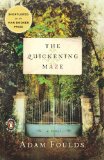Summary | Excerpt | Reading Guide | Reviews | Beyond the book | Read-Alikes | Genres & Themes | Author Bio

From the book jacket: It is 1855, and engineer William May has returned
home to his beloved wife from the battlefields of the Crimea. He secures a job
transforming London's sewer system and begins to lay his ghosts to rest. Above
ground, his work is increasingly compromised by corruption, and cholera
epidemics threaten the city. But it is only when the peace of the tunnels is
shattered by murder that William loses his tenuous hold on sanity. Implicated in
the crime, plagued by visions and nightmares, even he is not sure of his
innocence. Long Arm Tom, who scavenges for valuables in the subterranean world
of the sewers and cares for nothing and no one but his dog, Lady, is William's
only hope of salvation. Will he bring the truth to light?
Comment: Psychologically scarred William May, recently returned from the
the Crimean War, is a chief engineer on the London Sewer system - a monstrously ambitious project
encompassing 80 miles of brick built sewers, most of which are still in use today
(picture).
Unable to reconcile the horrors of his battlefield memories with his regulated
Victorian life, William keeps insanity at bay by cutting himself in the putrid
depths of the sewer system,
but his tenuous hold on sanity begins to slip when he, probably the only honest
engineer working the project, is framed for a brutal murder and starts to doubt
his own innocence. With his life on the line he has only one place to turn
- to Long-Arm Tom, a tosher*, who unbeknown by either of them is caught up in
the same web of corruption that is threatening to destroy William.
This is a gripping, richly atmospheric and exceptionally well researched first
novel that delivers a fast paced, credible story-line against the background of
one of the great feats of British architecture - the building of the London
sewer system (made all the more challenging because much of London is 30 feet
below the River Thames at high tide, making drainage by gravity alone
impossible). It also offers a vivid exploration of what it would
have been like to be mentally ill at a time when mental illness was seen as an
untreatable affliction, and more than half a century before the term shell-shock
was even coined, let alone widely acknowledged.
Little Known Facts About The History of Plumbing!
![]() This review
first ran in the November 12, 2006
issue of BookBrowse Recommends.
This review
first ran in the November 12, 2006
issue of BookBrowse Recommends.

If you liked The Great Stink, try these:

by Adam Foulds
Published 2010
In 1837 the great poet John Clare finds himself in High Beach - a mental institution on the outskirts of London. Soon another famed writer, the young Alfred Tennyson, moves nearby and grows entwined in the cloistered world of High Beach and its residents. (Paperback Original)

by Charles Todd
Published 2008
The nineth Inspector Ian Rutledge mystery, set in Post-World War I England. Rutledge is called on to prove the innocence of a man he dislikes and distrusts. But the deadly triangle also stirs up memories of the woman he himself loved and lost when he went to France to fight.
Your guide toexceptional books
BookBrowse seeks out and recommends the best in contemporary fiction and nonfiction—books that not only engage and entertain but also deepen our understanding of ourselves and the world around us.